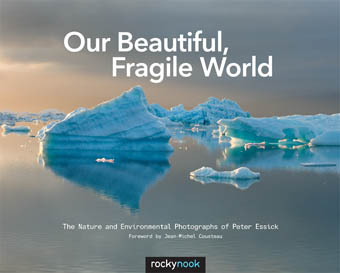PETER ESSICK
Editeur : EDITIONS ROCKY NOOK
Année de parution : 2013
Ses lecteurs apprécieront aussi les textes qui accompagnent chaque photo, où Essick raconte comment il a réalisé l’image et partage ses réflexions sur le problème abordé. OUR BEAUTIFUL, FRAGILE WORLD
“Most of the time, getting a unique photograph requires a lot of hard work. I have a saying: if it is easy, it probably has already been done. From a creative standpoint, an easy photograph is usually not very fulfilling,” writes photojournalist Peter Essick in his newly-released book, Our Beautiful, Fragile World. In the light of the work featured, this statement holds true.For the last twenty five years, Essick has traveled the globe to cover major environmental stories for the famed and revered National Geographic magazine. As glamorous as it sounds, the job is obviously not easy. As Essick puts it, you have to have “clear eyes and strong heart.” Being a NG photographer often means being on assignment for months and hiking the extra miles to get the right shot at the right time. In this business, producing beautiful pictures is not enough. Being on the environmental bit involves showing the “flip side of wild nature,” when “usually something has gone wrong.” In “Polluted Sinkhole, near Bowling Green, Kentucky”, Essick shows us two cows bathing in green water. The beautiful shades of green and the composition make it pleasant to the eyes. But what we are seeing is green because of the high density of algae generated by a runoff of excess nitrogen from fertilizers. “Straight pictures of pollution have almost lost their impact unless the degree of damage is extreme,” Essick notes. “The best pictures are the ones that ask questions or show part of the problem, those that are subtle and are not too direct.” What is compelling in Essick’s work – and in the case of most accomplished and successful photojournalists – is precisely the marriage of beautiful imagery that depicts unpleasant truth, the “terrible beauty” as referred to by one of his NG editors.
Readers will also appreciate the one-page text that accompanies each picture, where Essick reflects on the making of the image and shares his reflections on the issue at hand. Of all of the stories he covered, he said to be most proud of the large coverage he did on climate change in 2004. “I believe that it will stand the test of time and it was a big challenge for me to pull it off at the time.” With so much experience and so many images collected, one can ponder why he did not publish a book sooner in his career. Essick admits that he never really took the time to look back. “For most of my career I have been focused on the next story for NG. This was the first time I stopped for awhile and looked back at my work. It turned out to be a good exercise and I believe it will help me be a better photographer in the future. “

Lettre d’information
75004 Paris – France
+33 (0)1 42 74 26 36
ouverture du mercredi au samedi
de 13h30 à 18h30. Entrée libre
M° Rambuteau – Les Halles
Pour Que l’Esprit Vive
20 rue Lalande
75014 Paris – France
T. 33(0)1 81 80 03 66
www.pqev.org

